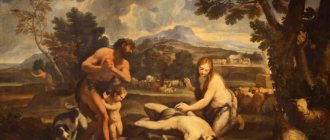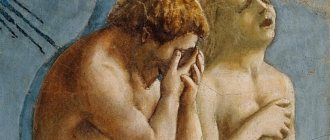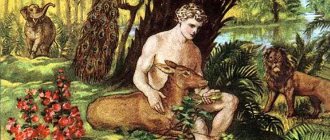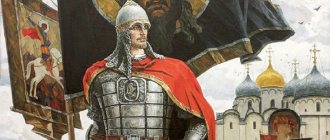The Old Testament story of Cain and Abel is well known to all Christians, since it tells about the terrible sin of fratricide. The biblical brothers were the children of Adam and Eve, expelled from Paradise after sinning, and became the first people born on earth. After the Lord kicked Adam and Eve out of Paradise, they were forced to work on the earth and lead their own lives so as not to die of hunger and cold, which their children later did. Abel was a sheep herder, and Cain was a farmer. Both brothers had different personalities. While Abel was peaceful and calm, Cain was not satisfied with many things, which became the foundation for the future murder.
Human ancestor Adam
Adam was the common ancestor of all people. He was created by the Almighty from the dust of the earth and received the breath of life during his creation. The name Adam means "man, son of the Earth." God created the wife and helper of the first man from his rib. He took out the bone while he was sleeping. The first man created and his wife were placed by God in the Garden of Eden.
Satan tempted Eve and Adam, and they tasted the forbidden fruit, violating the will of their Creator. The first woman ate the fruit first, and then she offered it to her husband, who followed her example. Because of this act, the Almighty punished them. He kicked them out of Paradise.
They began to live on the land cursed by the Lord. Adam had to work and cultivate the land in order to have food. After being expelled from the Garden of Eden, Adam and Eve had children.
The Bible mentions:
- Cain.
- Abel.
- Sif.
The first man created lived 930 years. All people are responsible for the sins of Adam and his wife.
Eva, the progenitor of humanity
In Hebrew, Eve means “life giver.” The first man himself gave the name to his wife. Eve is the foremother of humanity. According to the Bible, before Eve, Adam did not have a wife. She succumbed to the persuasion of the devil in the form of a serpent and violated the commandment of the Lord by eating the forbidden fruit. And then the first woman offered to do this to her husband Adam.
Eve (and her female offspring) was punished with the pains of childbirth. Another punishment is her attraction to her husband and dependence on him. The story of Adam and Eve teaches us to obey the Creator.
To those people who are interested in whether Adam and Eve had children during their life in Paradise, theologians, referring to the text of the Bible, answer that the first couple had them after their expulsion from Paradise. Adam and Eve had three sons who are mentioned in the Bible. The names of the remaining sons are unknown. The daughters of Adam and Eve are also mentioned in the Old Testament. Most likely, sisters and brothers married each other at that time.
Abel is the first person killed
The second son of Adam and Eve is Abel. In Hebrew, his name means “light breeze.” He was a shepherd. He had a brother named Cain. When the children of Adam and Eve made a sacrifice to the Creator, God accepted Abel’s sacrifice, which he brought from the firstborn of his flock and from their fat (fat), but did not accept his brother’s sacrifice from the fruits of the earth.
Cain killed his brother out of envy. Adam and Eve mourned Abel, but God, after these events, sent them another son. In the New Testament, the image of Abel is interpreted as one of the symbols of the innocent killed. There are many paintings of Adam and Eve mourning the body of Abel. They remind us that children suffer for the sins of the father.
Cain is the first criminal
Cain is the firstborn of Adam and Eve. The name Cain means "acquired" in Hebrew. When the ancestress of mankind gave birth to Cain, she said: “I have acquired a man from the Lord.” Cain and Abel are the first sons of Adam and Eve. As punishment for sin, God took away the fertility from the land that the eldest son of Adam and Eve cultivated. The creator doomed the first murderer to exile and wandering. Adam's first child settled in the land of Nod, where he became the father of Enoch and other children. He also built the first city.
Were sins committed before Cain?
Adam and Eve committed the first sin when they tried the forbidden fruit. This was original sin. Theologians believe that their actions are caused by pride. They, tempted by Satan, believed that they could achieve the power of the Creator.
Who were the wives of Cain, Seth and their descendants
Cain was the first to marry the children of Adam and Eve. “And Cain knew his wife, and she conceived, and gave birth to Enoch” (Gen. 4:17). The line of Cain began in the land of Nod (verse 16). Nod is related in meaning to the words “a wanderer who knows no rest” (navanad). That is, it was the land of “those who ran away from God.” Who was Cain's wife? Unlike the canonical text, the apocrypha and interpretations are replete with details of the family relationships of the first people. Many Jewish and Christian sources agree that Cain and Abel were married to their twin sisters. The apocryphal Book of Jubilees says: “And Cain took his sister Avan to wife, and she bore him Enoch at the end of the fourth jubilee. And in the first year of the first week of the fifth jubilee houses were built on the earth, and Cain built a city and called it after the name of his son Enoch.” Following the apocrypha, the Church Fathers (Epiphanius, Ephraim the Syrian, John Chrysostom) are of the opinion that Cain’s wife was one of his sisters. Since this was at the beginning of time and the human race needed to reproduce, it was allowed to marry sisters.
The sons and daughters of Adam represented not only a family, but also a clan, so the differences between brotherly and conjugal love became more pronounced only after the emergence of several families. Even in much later times and in civilized countries such unions were not considered incestuous. Athenian law required you to marry your sister if she did not find a husband at a certain age. For example, Abraham married his half-sister Sarah. Most likely, Cain got married even before the murder of Abel, since it is doubtful that any woman would have decided to marry a fratricide. Philo of Alexandria calls Cain's wife by name, Themech. Rabbinic literature simultaneously associates Cain's wife with his own twin sister, or with Abel's twin sister. One of the sisters, destined for Abel, was more beautiful, and Cain, wanting to marry her, committed fratricide. The Arab legend contains a similar interpretation. Modern Bible scholars also hold the view that the wife of the first son of Adam and Eve could have been one of his sisters. After the birth of his son, Cain built a city, naming it Enoch after his son. Thus, the biblical text speaks of an important event in the development of humanity - the transition from a nomadic to a sedentary way of life.
Cain's descendants most likely also married their closest relatives. The Book of Jubilees describes in detail all the marriages that took place, mentioning family ties and the names of the wives of the descendants of Cain. In the book of Genesis, only the wives of Lamech, Adah and Zillah, are named. Lamech's marriage is the first instance of polygamy. The third son of Adam and Eve, Seth, could also marry one of his sisters - the Book of Jubilees tells: “And in the fifth week of this jubilee Seth took to wife his sister Azura, and she bore him Enos in the fourth year.”
Quite an interesting evidence of marriages are the words at the beginning of chapter 6 of the book of Genesis: “When people began to multiply on the earth and daughters were born to them. Then the sons of God saw the daughters of men that they were beautiful, and they took them as wives as they chose.” This plot is based on myths about gods who took mortal women as wives, and about the heroes born as a result. Most Jewish and Christian interpreters understand the sons of God to be angels (Book of Enoch, Book of Jubilees, Philo, Justin the Philosopher, Irenaeus, Tertullian, Clement of Alexandria). Some rabbinic exegetes saw this as a reference to sons of the aristocracy marrying women of the lower classes. According to the third version of the interpretation, which is followed by the majority of the Church Fathers (Ephraim the Syrian, John Chrysostom, Jerome, Augustine, etc.) and modern researchers, the sons of God were the pious Sethites, and the daughters were the descendants of the Cainites.
If we take into account the latest DNA research, which indicates that all of humanity can be traced back to one pair of people, then the opinion that the wives of the first children of Adam and Eve were their sisters seems quite acceptable.
Is Noah a descendant of Cain or Abel?
Noah is a descendant of Seth. His father's name was Lamech, and his grandfather's name was Methuselah. The name Noah is interpreted as “calming, pacifying.” Some claim that Noah is a descendant of Cain, but this opinion is erroneous. It arose because Cain also had a descendant named Lamech. Some theologians believe that he was the first polygamist.
Who is Sif?
Seth is the third son of Adam and Eve. He was born after Cain, out of envy, took the life of Abel. His name translates as “foundation, affirmation.” After the Creator cursed Cain and his offspring, Seth began to bear the promise.
The Bible says that Seth was 912 years old when he died. His first son was named Enos. The third son Adam had other children. The name Seth means "recompense." Eve named her son that because she believed that he had appeared to become a replacement for the deceased Abel.
Biblical Seth, son of Adam, born at the end of the tenth century AD
The era of the birth of astronomy can be dated and this is a very interesting scientific problem. The basis for this dating is Ptolemy’s Almagest, the most complete collection of ancient astronomical knowledge. In 1991 - 1993, we, together with Professor V.V. Kalashnikov, carried out extensive research on the dating of the oldest sections of the Almagest, see KhRONZ. Which, as it was discovered, primarily includes the Almagest star catalog. At least that part of it, which includes observations of the brightest and most famous stars in the sky. The result was as follows. The old core of the star catalog and the entire Almagest as a whole dates back to the era from 600 to 1300 AD, with the most likely dating being the 10th – 11th centuries. We emphasize that from the point of view of the new chronology, this is a very ancient era.
Why did we remember this here? The fact is that in the minds of medieval people, ancient knowledge, including astronomical knowledge, was firmly associated with the Chaldean Kingdom. The Chaldeans were stargazers and invented astronomy and astrology [154]. As we are now beginning to understand, we are talking about the Roman (Byzantine) Kingdom of the 10th – 13th centuries, in particular, about Byzantium in the era of Andronicus-Christ. Hence the name Chaldea itself, see above. The question arises: are there sufficiently clear traces of astronomy and astrology in the Byzantine history of those times? Yes, there are such traces and there are extremely many of them. Let's look at them in more detail.
The “History” of Niketas Choniates, which describes the reign of the Komnenos, is literally filled with references to stars and astrologers. All Comneni, according to Choniates, attached great importance to astronomical events. Manuel Comnenus, for example, at the end of his life “was carried away... by astrology to such an extent that somehow, expecting a calculated collision of two stars, he ordered, as a precaution, to remove the frames with glass from the palace windows so that they would not break from the shock” [44], with . 255.
Moreover, “Manuel made all the most important and greatest matters... dependent on the mutual relationship of the stars, on their known position and movement, and took the words of astrologers for the sayings of the oracle” [140], p. 167. However, it is emphasized that Andronicus himself was indifferent to the predictions of the stars [140], p. 167, 347.
Nikita Choniates notes that astrology at that time was “a rather ordinary thing” [140], p. 347. Under Alexei Angelus-Comnenus, there was even an attempt to proclaim one of the astrologers emperor [141], p. 114. This is how, for example, the installation of Alexei Angel-Comnenus as king is described. “Having then entered the famous and most magnificent temple of the Wisdom of God for the usual anointing of the kingdom and the imposition of signs of power on himself, he ... stood in front of the doors for quite a long time, waiting until he was allowed to enter according to the HOROSCOPE, standing near the place of the catechumens ASTROLOGERS, who were supposed to notice and determine with all accuracy the happy minute of time” [141], p. 116. And so on.
If we use an overview of Byzantine history, for example, the book “Emperors of Byzantium” by S. B. Dashkov, it is striking that the wave of passion for astrology at the imperial court arose precisely in the era of the Komnenos of the 11th – 12th centuries [44].
We see the same era - from the middle of the 11th to the middle of the 14th century - in the thickening of the dating of the “ancient” Egyptian zodiacs. And not only Egyptian ones. We also dated other ancient zodiacs, see our books: “New Chronology of Egypt”, 2nd edition and “New Chronology of India”.
As mentioned above, the burial places of the Egyptian pharaohs are actually the tombs of the kings of the Empire. The capital of which in the era before the great = “Mongol” conquest of the 14th century was in Tsar Grad on the Bosphorus. Then she moved to Vladimir-Suzdal Rus'.
The origin of astronomy and astronomical fortune-telling (astrology) in the era of the 11th century is directly noted in the famous “Alexiad” of Anna Komnena [79]. Of course, today we have a late edition of this text, but nevertheless, quite a lot of valuable information has been preserved there. Describing the reign of his father, Alexei I Komnenos, supposedly 1081 - 1118 [44], p. 238, - Anna says the following: “I... will briefly talk about predictions. THIS IS A NEWEST INVENTION – THIS SCIENCE DIDN’T EXIST IN ANCIENT TIMES. Methods of prediction were not known at the time of the most learned astronomer Eudoxus, Plato had no idea about this, and even the astrologer Manetho was not experienced in this science. Divining, they did not know how to obtain a horoscope, establish centers, observe the location of constellations and everything else that the inventor of this method passed on to subsequent generations... At that time there was no shortage of astrologers: JUST THEN THE MENTIONED SIF PROSPERED and generously revealed the secrets of astrology THE FAMOUS EGYPTIAN FROM ALEXANDRIA. Answering numerous questions, this Alexandrian very accurately predicted the future, and in some cases did not even use an astrolabe... There was nothing magical about this - the Alexandrian prophesied thanks to the art of logical thinking. The autocrat saw how young people, considering the Alexandrian to be some kind of prophet, flocked to him. He himself turned to him twice with questions, and both times the Alexandrian answered them successfully. Alexey feared that... a craze for astrological pseudoscience would begin, so he expelled the Alexandrian from the city and assigned him REDESTO for his place of residence. The emperor showed great care towards him and generously provided him with everything he needed at the expense of the treasury” [79], p. 186 – 187.
Anna told us a lot of interesting things. Firstly, it is directly stated that prediction by the stars came into fashion at the beginning of the 12th century, during the era of the Komnenos. This corresponds to the indications of Byzantine sources and the dating of Egyptian tombs, see above. Among the Egyptian datings we have calculated, most fall into the 12th century. And only a very few ended up in the 11th century. There are no datings earlier than the middle of the 11th century.
Secondly, it talks about the famous astrologer Seth. This is interesting because in old Christian texts the invention of the sciences, and in particular astronomy, is attributed to the biblical Seth. According to the Bible, Seth is the son of Adam. In Christian tradition it is believed that he was the first sage on earth. In particular, “tradition ascribes to Seth the invention of letters” [154]. It turns out that the biblical Seth lived in the era of Alexei Komnenos, that is, at the end of the 11th - beginning of the 12th century. Anna Komnena writes the following about him: “A certain mathematician named Sif, who was very arrogant about his knowledge of astrology... outlined his prophecy on paper, which he sealed and handed to the emperor’s entourage, ordering it to be kept until a certain date. Then... they opened this paper... Everyone was amazed at the scholarship of this man, who had reached the pinnacle of his science” [79], p. 185 – 186. Modern commentators explain: “Sif, physician, scientist and translator of the second half of the 11th century” [79], p. 520.
In the Palea we mentioned [104] the following is said about Seth: “About Seth. and Adam lived 230 years and gave birth to Seth. indict 5. the circle of the sun 7. the ring finger, and the Moon 6... and a Jewish letter was given to him. This wise man set the times for the Sun and the Moon and the stars. in summer and month and week and day and hour. these people have called God” [104], sheet 16 ver. See fig. 6.4.
Rice. 6.4. Palea's text about Seth. The extract was made by G.V. Nosovsky in the Manuscripts Department of the State Library in 1992. The manuscript is stored in the Rumyantsev Fund of the State National Library, Moscow, code F. 256.297.
In the famous “Chronicle of Hellenism and Rome” we read the following: “Created, recreated, Adam became the earth from God... And his wife Eva gave birth to three sons: Cain and Abel and Seth, and two daughters: Azara and Asumu. His son Seth had wisdom from God and by the command of God created names for all the stars, and 5 transitions (planets - Author.
) known to be people: the first called Kron, the 2nd Dia, the 3rd Areya, the 4th Aphrodite, the 5th Ermin. And about the seven stars called besides the five and about the two lamps of the decree, and the Jewish letter... For God was then called Seth, who did not then know how to write the Jewish letters and names the stars” [85], p. 4.
Thus, Seth, the son of Adam, is considered in biblical history to be the inventor of astronomy and the very first Jewish literacy on earth. That is, the inventor of writing. But then it is interesting to calculate the time when Adam and Seth lived. And now we have such an opportunity. At the same time, we will check whether Anna Komnena is right in asserting (allegedly at the end of the 11th - beginning of the 12th century) that Seth lived in the era of Alexius I Komnenos or shortly before it.
The data given in the Palea for the birth of Seth, son of Adam, is as follows:
1) Indict 5.
2) Circle to the Sun 7 of the ring finger or, in case of a possible mirror image, 7 of the index finger. That is, 6 or 17, respectively, see fig. 1.33.
3) Circle of the Moon 6.
The calculation using the computer program we wrote (see Appendix 3) gave the following answer:
NIRTH DATE OF SETH, SON OF ADAM, ACCORDING TO PALEIA F.256.297
The asterisks in the table indicate: the ring finger indicated in Paley, as well as the “dual” index finger (with the possible mirror image mentioned above in Chapter 1).
The table contains only one date that makes sense from the point of view of the new chronology. Namely, 977 AD. We can even pinpoint the time of year when Seth, the son of Adam, was born. Since there were no corrections in the circles for the Sun and Moon, the biblical Seth was born between March and December 977 AD. See Chapter 1. Consequently, his creative activity occurred in the first half or even the middle of the 11th century. That is, immediately before the reign of Alexei I Komnenos. And exactly in the era where our dating of the Almagest star catalog most likely points, see KhRON3. And also our dating of the establishment of the Metonic cycle, the astronomical basis of the Christian Paschal. Thus, the dates corresponding to the era of the birth of astronomical knowledge clearly indicate the era of the biblical Seth, the son of Adam, namely, in the 10th – 11th centuries. This indirectly implies the dating of Adam's life to the tenth century. Of course, a new era. This ideally corresponds to the decomposition of the Global Chronological Map, see KhRON1 and the conclusion made by A. T. Fomenko back in 1990 about the beginning of written history no earlier than the 10th century AD. In fact, if the invention of writing falls on the 10th century AD, then we cannot learn anything about earlier eras. And about the era of the X - XI centuries - only very little. Dull, half-erased memories.
Dating the birth of Seth and the invention of writing according to Palaea in the 10th – 11th centuries AD. is in excellent accordance with the hypothesis we already expressed back in 1998 that writing was invented in the era of the 10th – 11th centuries.
Let's return to Anna Comnena. Thirdly, in her text, Anna’s testimony about the famous Alexandrian astronomer of the late 11th – 12th centuries (the era of the reign of Alexios I Komnenos), to whom the emperor assigned a place of residence in a certain REDESTO and supplied him with everything necessary for astronomical studies, is interesting. But from the history of astronomy we know that there really was an “ancient” astronomer Hipparchus, who worked at RHODES. In particular, Ptolemy, in his Almagest, used his observations to calculate precession, see CHRONZ, part 1. Ptolemy reports that Hipparchus' observations were made about 250 years before him. According to the chronology of the Almagest, restored by us in KHRONZ, Hipparchus’s observations of the Sun and Moon date back to 1113, that is, exactly the time of the reign of Alexius I Komnenos, see KHRON3, ch. 10. See also our book “Astronomical Analysis of Chronology”, p. 471.
It is known that the “ancient” Hipparchus observed the outbreak of a nova. Moreover, it is believed that Hipparchus began compiling a star catalog after he noticed a nova OUTburst [74], p. 51. This unique event “prompted Hipparchus to think that certain changes might be taking place in the stellar world” [74], p. 51. Now we understand exactly what kind of outbreak Hipparchus observed. It was the Star of Bethlehem from the mid-12th century. As for the name HIPPARCHUS, in our opinion, which we have already expressed more than once, it is quite late and comes from the name of the 16th century astronomer TYCHO BRAHE, see CHRONZ, ch. 10. It is known that he took up astronomy after he was struck by a supernova on November 11, 1572 [74], p. 124 – 125. Scaligerian editors of the 17th century clearly used the biography of Tycho Brahe to fill in details the long-lost biography of the “ancient” astronomer of the 12th century. So he could have acquired the name HIPPARCH - a corruption of TYCHO BRAHE - etc. Anna Comnena, by the way, does not even know the name of the “Alexandrian astronomer.”
The star theme also sounds loudly in the legends about God Kolyada. For example, the Gospel Magi in the songs of the Bulgarian-Pomaks “having read the STAR BOOK”, see above, it is from it that they learn about the born God Kolyada (Jesus Christ). Or here's another fragment.
"Three kings, great boyars,
Three kings from the ends of the earth,
Three kings of the Black Harapin
SINGING THE STAR BOOK,
Boyar Star Book -
What they sang, they saw” [29], Song 12, lines 160 – 165.
Quite a lot is said in songs about this star book. It is sung, that is, read, not only by the three Magi, but also by their “old grandfather”, see, for example, [29], Song 12, lines 230 – 240. Note that the first astronomical works were written IN VERSES, for example, famous astronomical poem by Aratus. “Arat (Greek Aratos) from Soloi (Latin Soli) in Cilicia - known for his poetic and prose works of various kinds, lived around 270 BC. (erroneous Scaligerian dating - Author.
). He processed, by the way, although he himself was not an astronomer, the astronomical system of Eudoxius of Cnidus in the Greek POETIC TEXTBOOK... with the application of signs of the weather” [154].
Let's draw a conclusion. The era of the 12th century, that is, the era of Christ, was a time when astronomy and, perhaps, writing itself, were relatively recently born. About a hundred years earlier. The era of Christ was a time of fascination with astronomy and astrology. For chronology, it is important that astronomical knowledge was used not only for fortune telling, but also for recording dates. For example, in the royal burials of “Ancient” Egypt. Thanks to this, today we are able to restore the exact dates of some events of that era. Almost no written information has reached us about eras older than the 10th – 11th centuries. Interestingly, the era of the first man Adam is dated in old sources to the 10th century AD.
What changed after the flood?
All sinners perished during the flood. The waters of the flood cleansed the entire earth. Therefore, no one could harm Noah’s righteous family. Some theologians argue that after this punishment the climate changed. They refer to the fact that after the flood, for the first time, the Holy Scriptures speak of winter and summer.
And also, according to the Bible, the life span of people has been shortened. There is a hypothesis that the natural conditions before the Flood were such that people could live ten times longer than now. Other theologians argue that after the Flood there were changes in human genetics.
Long-lived patriarch
Reading the Book of Genesis, an attentive reader can calculate that Adam lived a total of about 900 years. He spent most of this time with Eve. The famous ancient philosopher and interpreter of the Holy Scriptures, Josephus Flavius, wrote that over the entire period of time, Eve gave birth to 33 sons and 22 daughters. In the absence of other opportunities and restrictions on consanguinity, brothers and sisters could marry without hindrance. Considering that the grandchildren and great-grandchildren of the first people also had a colossal life span, their offspring were extremely numerous.
How to prevent a flood again?
For a Christian, the death of civilization from the Flood reminds him of the reason for the punishment. In chapter 9, God promises that he will no longer send floods that can destroy all life, but people remember that the Creator punishes sinners.
In order for God not to subject people to such punishment, one must follow His will.
The rainbow covenant means that humanity will definitely live to see the Second Coming of Jesus Christ, who will judge everyone. But it must be remembered that humanity can be overtaken by punishment of a different nature.
Adam, Eve, Cain, Abel, Seth, Noah, like all mortals, sinned. We need to learn from their fates. Humanity in our time is faced with a choice: God or Satan. Every person is endowed with free will, so he must make his own decision.
People who choose corruption, hatred and life without God will regret it when the time of Judgment comes. The global flood reminds us of the inevitable punishment for all sinners.
Rate this post
The following two tabs change content below.
- Author
- Latest articles
avramenko1
Mythical and real
The Hebrew authors did not take the opportunity to have healthy children from repeated consanguineous marriages out of their own imaginations. In addition to the Old Testament, the insignificance of the problem of degeneration in the ancient world is confirmed by the history of the dynasties of the ancient Egyptian pharaohs. Considered "gods in the flesh", they could not take partners other than relatives, and separate dynasties ruled for many centuries. As a result of incest, such great figures as Cheops and Djoser were born and ruled. Thus, the Christian assertion that all people are brothers and sisters takes on a completely practical character.









